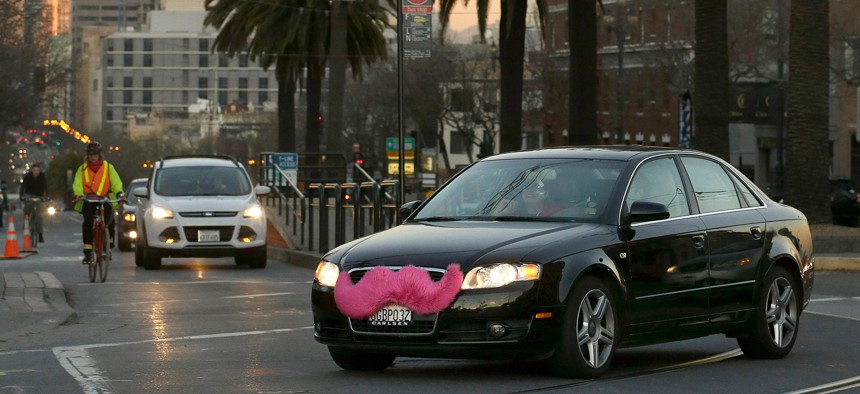The Truth About the Gig Economy

In this Jan. 17, 2013, file photo, a Lyft car crosses Market Street in San Francisco. AP Photo
Uber and similar companies aren’t driving huge changes in the way that Americans make a living.
The workforce is getting Uberized. The gig economy is taking over the world. Independent-contractor jobs are the new normal. In the postrecession years, this became conventional wisdom, as more and more Americans took jobs—well, “jobs”—with companies such as Postmates, Fiverr, TaskRabbit, and Lyft. But the gig economy was then and is now a more marginal phenomenon than it might have seemed.
Last week two influential labor economists revised down their much-cited estimate of the size of the alternative workforce, meaning workers in temporary, on-call, contract, or freelance positions. Lawrence Katz of Harvard and Alan Krueger of Princeton had initially found that this workforce grew five percentage points in the decade up to 2015, accounting for nearly all job creation over that time period. Now they think it is more like one or two points. Their correction comes shortly after a major government survey—one that surprised a lot of labor and workforce experts—found that 3.8 percent of workers held “contingent” jobs as of 2017, roughly the same share as in 2005.
The gig economy might be new and big and radical and transformative. It might represent a powerful business model for venture investors and tech companies. But Uber and similar companies were not and are not driving tidal changes in the way that Americans make a living.
Wild predictions aside, it was always clear that many gig workers were taking on these kinds of jobs as a temporary stopgap or as a way to supplement their income, rather than as a substitute for a full-time position. A comprehensive look at the Uber workforce by Krueger and Jonathan Hall, the company’s internal head of economic research, found that “most of Uber’s driver-partners had full- or part-time employment prior to joining Uber, and many continued in those positions after starting to drive with the Uber platform.” Other surveys showed that most gig-economy workers were on the job only intermittently. The gig economy was providing a lot of work but not a lot of jobs, in other words.
Figuring out how many jobs the gig economy was creating turned out to be hard to do, too. In 2015, Krueger and Katz were trying to fill a “void” in the public understanding of how many Americans were in contingent- or alternative-work arrangements, since the government had stopped conducting its own survey on the question. They were comparing different points in the business cycle and using inconsistent surveys to do that, they note in their newer paper. Moreover, the surveys they were using had shortcomings: Respondents were just not great at accurately identifying what kind of work they were doing, for instance.
There’s another reason why a false narrative might have hold: Gig work is vastly more prevalent in the big coastal cities where many investors and journalists live, leading to a kind of media myopia about the scale of the phenomenon. And gig work seemed like the future. It suddenly appeared during the brutal years following the financial crisis, at the same time that declining unionization rates, widening inequality, and the spiraling cost-of-living crisis, among other trends, were battering working families. Given widespread fears about the ways that automation and technology might further shock the American workplace, it just stood to reason that in the coming dystopia, everyone would have to settle for “jobs” with little security, low pay, and no benefits.
The gig economy isn’t taking over, but it has become a useful emblem of what it is like to work for a living in late-stage capitalism. No wonder it seemed to be everywhere.
Annie Lowrey is a Staff Writer at The Atlantic, which originally published this article.
NEXT STORY: Airports Are Feeling the Shutdown Pressure





